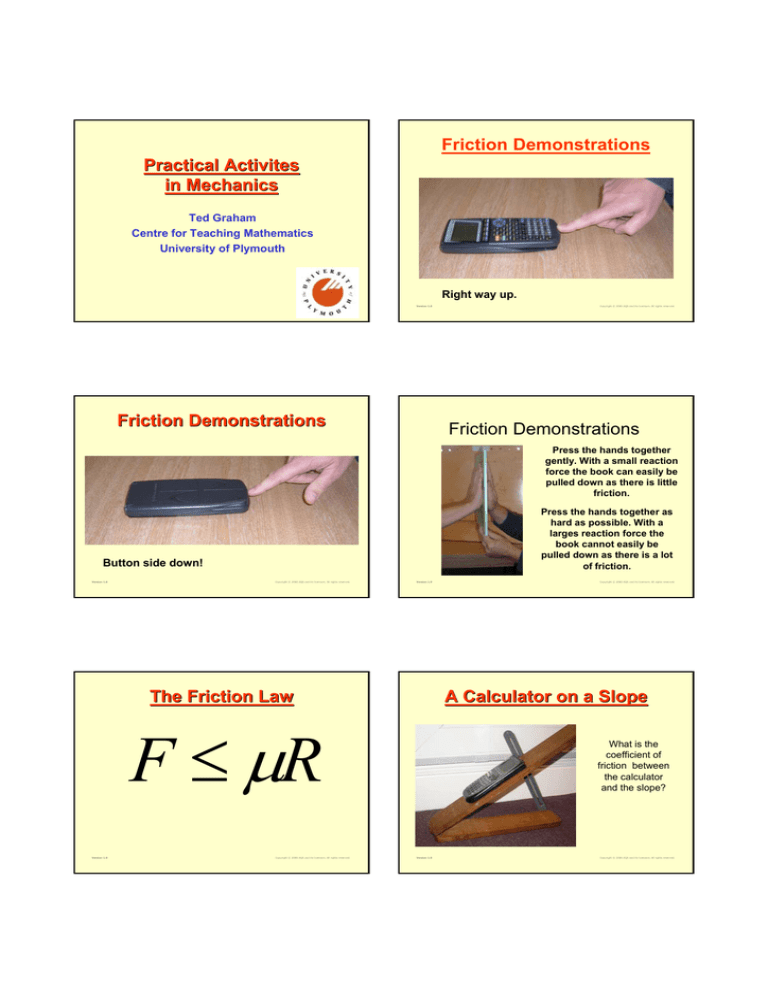
Friction Demonstrations
Practical Activites
in Mechanics
Ted Graham
Centre for Teaching Mathematics
University of Plymouth
Right way up.
Version 1.0
Friction Demonstrations
Copyright © 2008 AQA and its licensors. All rights reserved.
Friction Demonstrations
Press the hands together
gently. With a small reaction
force the book can easily be
pulled down as there is little
friction.
Press the hands together as
hard as possible. With a
larges reaction force the
book cannot easily be
pulled down as there is a lot
of friction.
Button side down!
Version 1.0
Copyright © 2008 AQA and its licensors. All rights reserved.
Version 1.0
The Friction Law
A Calculator on a Slope
F ≤ μR
Version 1.0
Copyright © 2008 AQA and its licensors. All rights reserved.
Copyright © 2008 AQA and its licensors. All rights reserved.
What is the
coefficient of
friction between
the calculator
and the slope?
Version 1.0
Copyright © 2008 AQA and its licensors. All rights reserved.
Unknown Hanging Masses
Solution
R
F
Parallel to the slope
F = mg sin θ
mg
θ
What are the
unknown
masses.
Perpendicular to the slope
R = mg cos θ
Use the friction inequality
F ≤ μR
mg sin θ ≤ μmg cos θ
mg sin θ
mg cos θ
μ ≥ tan θ
μ≥
Version 1.0
Solution Part 1 (Forces)
Copyright © 2008 AQA and its licensors. All rights reserved.
Solution Part 1 (Equations)
T1
T1
T2
α
T1
m2g
m1g
T1
m1g
T2
β
T2
α
T2
Mg
β
m2g
T1 = m1 g
Mg
T1 cos α + T2 cos β = Mg
T2 = m2 g
T1 sin α = T2 sin β
Version 1.0
Copyright © 2008 AQA and its licensors. All rights reserved.
Version 1.0
Copyright © 2008 AQA and its licensors. All rights reserved.
Solution Part 3 (Algebra)
Alternative Solution
T1 cos α + T2 cos β = Mg
T1 sin α = T2 sin β
m1 g sin α = m2 g sin β
m sin β
m1 = 2
sin α
m1 cos α + m2 cos β = M
m2 sin β
cos α + m2 cos β = M
sin α
sin
β
⎛
⎞
cos α + cos β ⎟ = M
m2 ⎜
⎝ sin α
⎠
M
m2 =
sin
β
⎛
⎞
cos α + cos β ⎟
⎜
⎝ sin α
⎠
α
θ
Mg
β
m1 =
m2 sin β
M sin β
M sin β
=
=
sin α
sin β cos α + sin α cos β sin (α + β )
T1 = m1g
T2 = m2g
θ = 180 − α − β
m1 g
Mg
=
sin β sin θ
M sin β
m1 =
sin θ
m2 g
Mg
=
sin α sin θ
M sin α
m2 =
sin θ
Coefficient and Angle of Friction
First determine the
coefficient of friction.
Then predict the greatest
angle for which the block will
remain at rest on the slope.
Coefficient and Angle of Friction
T=F
R = Mg
R
T
F
Mg
T
T = mg
T=F
Test you prediction.
Version 1.0
Copyright © 2008 AQA and its licensors. All rights reserved.
Version 1.0
Air Resistance Problem
mg = μR = μMg
m
μ=
M
s = ut +
s
Compare with the time to fall
under gravity alone.
a=
Determine the average
resistance force acting as the
object falls
Copyright © 2008 AQA and its licensors. All rights reserved.
Air Resistance Problem
R
mg
Version 1.0
Resultant Force = mg − R
2s
t2
Copyright © 2008 AQA and its licensors. All rights reserved.
Set up the apparatus
as shown in the
diagram. Use a
difference of 10
grams. Predict the
time for the lower
mass to rise to level
of the pulley. Confirm
with an experiment.
mg − R = ma
2ms
t2
2ms
R = mg − 2
t
Copyright © 2008 AQA and its licensors. All rights reserved.
1 2
at
2
Vertical Connected Particles
mg − R =
Version 1.0
Copyright © 2008 AQA and its licensors. All rights reserved.
Air Resistance Problem
Find the time taken for the
cone to fall from a
reasonable height to the
ground.
Version 1.0
mg
Version 1.0
Copyright © 2008 AQA and its licensors. All rights reserved.
Vertical Connected Particles
T
Vertical Connected Particles
T
T − mg = ma
mg
Mg − T = Ma
a=
Mg
s
Mg − mg = Ma + ma
(M − m) g
a=
M +m
Version 1.0
(M − m) g
M +m
s = ut +
Copyright © 2008 AQA and its licensors. All rights reserved.
Conical Pendulum Practical
Version 1.0
1 2
at
2
Copyright © 2008 AQA and its licensors. All rights reserved.
Conical Pendulum Practical
Set up a conical pendulum
with the mass close to the
floor.
Measure:
•Diameter of circle
•Height of suspension point
•Time for 10 circles
Calculate the angular speed
in two different ways and
compare.
Version 1.0
Copyright © 2008 AQA and its licensors. All rights reserved.
Version 1.0
A Coin on a Cylinder
Copyright © 2008 AQA and its licensors. All rights reserved.
A Coin on a Cylinder
Assume R = 0
R
θ
mg
mg cos θ = m
cos θ =
Version 1.0
Copyright © 2008 AQA and its licensors. All rights reserved.
Version 1.0
v2
r
v2
gr
Copyright © 2008 AQA and its licensors. All rights reserved.
A Coin on a Cylinder
mgr (1 − cos θ ) =
R
θ
Version 1.0
A Coin on a Cylinder
1 2
mv
2
Start the coin part
way round the
cylinder as shown in
the photo.
v 2 = 2 gr (1 − cos θ )
mg
cos θ =
v2
= 2(1 − cos θ )
gr
cos θ =
2
⇒ θ = 48°
3
Copyright © 2008 AQA and its licensors. All rights reserved.
Make a prediction
and test your result.
Version 1.0
Copyright © 2008 AQA and its licensors. All rights reserved.
Energy Lost?
Energy Lost?
H
Drop the whole thing so
that the small ball just
reaches a particular
height, for example the
ceiling.
Find the energy lost
during the bounce.
h
Determining the Mass of a Metre
Rule
Determining the Mass of a Metre
Rule
If on the point of toppling:
R
Mg × a = mg × b
Mg
Version 1.0
Copyright © 2008 AQA and its licensors. All rights reserved.
Version 1.0
a
b
mg
M=
mb
a
Copyright © 2008 AQA and its licensors. All rights reserved.
Determining the Mass of a Metre
Rule
The Suspended Beam
Checking the prediction.
Version 1.0
Copyright © 2008 AQA and its licensors. All rights reserved.
Version 1.0
Perpendicular Distances
Version 1.0
Copyright © 2008 AQA and its licensors. All rights reserved.
Copyright © 2008 AQA and its licensors. All rights reserved.
Perpendicular Distances
Version 1.0
Copyright © 2008 AQA and its licensors. All rights reserved.
The Centre of Mass of a
Lamina
Balance a Coke Can
12 cm
15 cm
9 cm
20 cm
x=
120 × 4 + 108 ×14 166
=
= 8.74
120 + 108
19
y=
120 × 7.5 + 108 × 4.5 231
=
= 6.08
120 + 108
38
The Centre of Mass of a
Lamina
8.74
Centre of Mass of a Lamina
θ
6.08
6.08
8.74
θ = 34.8°
tan θ =
Version 1.0
Copyright © 2008 AQA and its licensors. All rights reserved.






